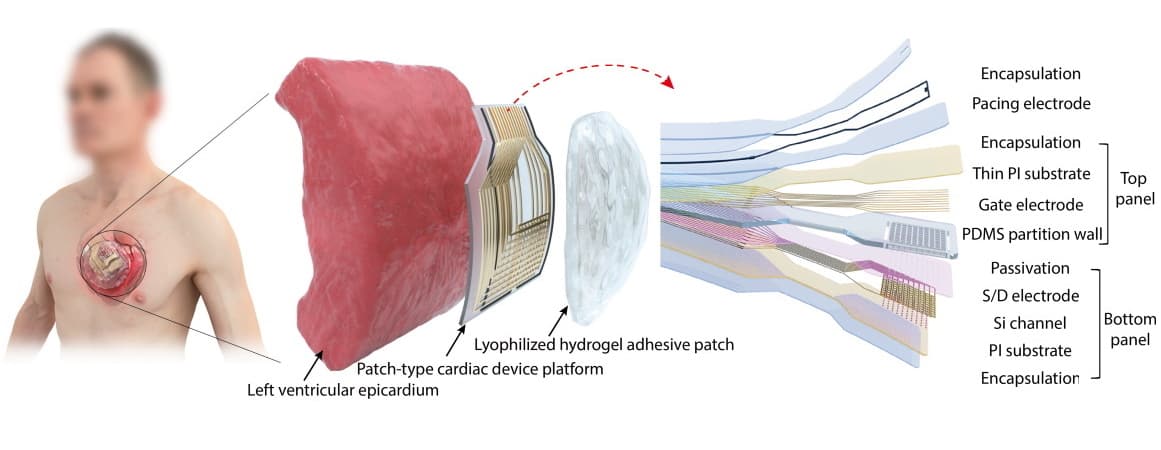Replacing a pacemaker with a device the width of a human hair
01 Nov 2022
Cardiac patch: Schematic of the device, which comprises an array of pressure-sensitive transistors and biocompatible pacing electrodes with encapsulation layers. The device is attached to the epicardium using a hydrogel adhesive patch. (Courtesy: J C Hwang et al Sci. Adv. 10.1126/sciadv.abq08/CC BY-NC)
Scientists have fabricated and successfully tested an ultrathin patch-type cardiac device that can monitor a heartbeat and apply stimulations as necessary.
Currently, these functions are performed by bulky and intrusive devices such as pacemakers. While these were miracle machines for many decades, the surgery required to implant pacemakers is complicated and can be risky. The new device, on the other hand, has a unique adhesive that allows it to stick directly to a wet organ such as the heart.
The researchers, from Yonsei University in Korea, believe that the platform they have developed may one day replace pacemakers and therefore avoid unnecessary surgical risks. The team has so far only tested the device on a live rabbit model and an artificial heart, but successful results suggest that this is a promising new technology that bears further investigation.
Can this replace a pacemaker?
A key heart problem that the researchers addressed with their research is cardiac arrhythmia, or an irregular heartbeat. The heart can beat too fast, too slow or erratically. Regardless, the cause of cardiac arrhythmia is the improper function of electrical impulses that are supposed to coordinate heartbeats. Sometimes heart arrhythmias are unnoticeable or simply a minor annoyance, but in certain situations they can be life-threatening. If the problem becomes severe enough, the surgical implantation of a pacemaker may be the only remaining option.
The research performed here may give patients a less invasive option, which would give more people the option to monitor and halt cardiac arrhythmias. The new device is a tiny platform consisting of an active-matrix array of pressure-sensitive transistors that can detect heartbeats, along with low-impedance electrodes to stimulate the heart and halt arrythmias. In tests on rabbits, the device was able to detect cardiac arrhythmias and apply suitable electrical treatment to correct the abnormal heart rhythms.
One of the more promising aspects of this new platform is just how thin it is. The sheet of sensors has a total thickness of 38 μm. For reference, a standard pacemaker is about the size of a matchbox and human hairs are generally between 17 to 181 μm thick. Clearly, the platform investigated here is many orders of magnitude smaller than our current best solutions to heart monitoring and stimulation.
In addition to the device’s tiny size, the researchers also developed an unusual method for attaching it to the heart itself. Currently, pacemakers have a generator that attaches to a wire running through a blood vessel in the heart. The new platform works more like a piece of tape stuck on the heart’s epicardium.
The reason this is such an incredible revelation is the same reason that can cause frustration when trying to tape something to a wet surface. Much like putting a piece of labelling tape on a food container with condensation, adhering a patch-type cardiac device to a heart for a long period of time was a challenge. To solve this problem, the researchers looked to nature. Specifically, they found an alginate-based hydrogel adhesive that mimics the adhesive properties of mussels in underwater environments. Not only does this adhesive stick to the wet epicardium, but it also won’t be resorbed by the body, and it is biocompatible and nontoxic for humans.
What’s next?
Of course, there is still work to be done if these kinds of devices are ever to replace pacemakers at a significant scale. To begin, the researchers only performed in vivo testing on rabbits and on an artificial heart. Further work will be required before we can start trusting this technology with human lives.READ MORE

Additionally, the researchers believe that cardiac arrythmia is only the beginning. They expect this method to expand toward studying and monitoring other heart diseases, such as myocardial infarction, hypertrophic cardiomyopathy, concentric hypertrophy and dilated cardiomyopathy.
The team describe the cardiac device in Science Advances.
Kevin Jackson is a freelance science writer based in the US.
from physicsworld.com 15/11/2022

Δεν υπάρχουν σχόλια:
Δημοσίευση σχολίου